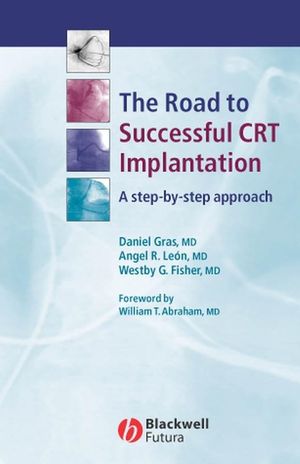The Road to Successful CRT Implantation: A Step-by-Step ApproachISBN: 978-1-4051-1718-0
Paperback
112 pages
June 2004, Wiley-Blackwell
 This is a Print-on-Demand title. It will be printed specifically to fill your order. Please allow an additional 10-15 days delivery time. The book is not returnable.
|
||||||
Foreword.
General remarks.
1 How does ventricular dyssynchrony alter hemodynamic function?.
2 What clinical benefits can we expect from CRT?.
3 How to select candidates for CRT.
4 Assessment of ventricular dyssynchrony by new echocardiographic analyses.
5 What are the mechanisms of improvement during CRT?.
6 Clinical situations where CRT is unlikely to be of therapeutic value.
7 Preimplantation checklist.
8 Right versus left-sided approach to implant the CRT system.
9 Right ventricular pacing in CRT.
10 How to achieve reliable sensing and pacing of the right atrium.
11 Is it safe to pace the left ventricle via a coronary sinus tributary?.
12 Why perform a coronary sinus venogram before placement of the.
left ventricular lead?.
13 Optimal LV lead positioning.
14 How to manage difficult coronary sinus cannulation.
15 How to avoid a dissection of the coronary sinus ostium.
16 How to overcome a myocardial bridge over the coronary sinus.
17 What to do in the absence of a lateral branch on the venogram.
18 How to manage high left ventricular pacing thresholds.
19 How to proceed in the presence of a complex coronary sinus anatomy.
20 How to manage diminutive target coronary sinus tributaries.
21 What to do when valves are in the way.
22 How to implant a CRT system in the presence of a left superior vena cava.
23 Dilatation of the target cardiac vein by angioplasty techniques.
24 Stenting for recurrent dislodgment of the left ventricular lead.
25 Assessment of the electrical signal sensed by the left ventricular lead.
26 How to avoid stimulating the left phrenic nerve.
27 Dye extravasation and venous perforation or dissection.
28 How to avoid a cardiac vein dissection by the balloon catheter.
29 How to remove the guiding sheath using the slitting technique.
30 Radiographic appearance of the final lead position of the CRT system.
31 How to implant a CRT device in patients with chronic atrial fibrillation.
32 Upgrading DDD pacing to CRT.
33 Upgrading a CRT to a CRT-ICD system.
34 Repositioning of a dislodged left ventricular lead.
35 How to implant a four-chamber CRT system.
36 How to implant a biventricular, double-left ventricular lead CRT system.
37 Alternatives in left ventricular lead implant failures.
38 Left ventricular lead extraction.
39 Management of ventricular double counting in CRT.
40 Management of non-responders to CRT.
References.
Index.



